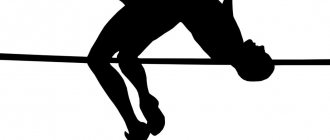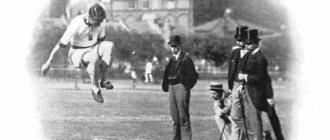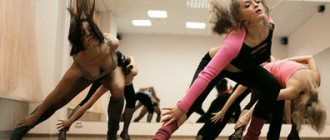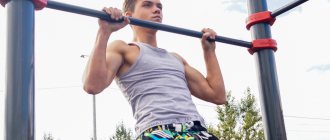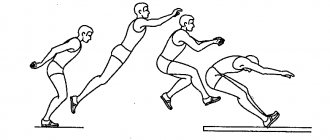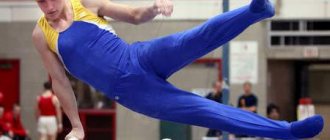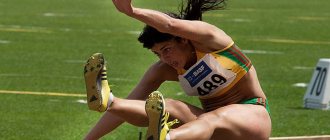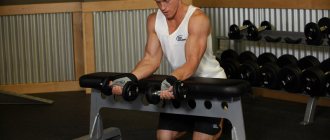AIR ALERT III
The program was developed by TMT sports based on the very popular program, Air Alert II. The program has undergone many changes. Due to the new exercise and the increase in the course (15 weeks), the creators reduced the frequency of the exercises to 3 days a week (except for the last, 15th week), but now it will have to be performed on certain days of certain weeks! After completing the full course (15 weeks), you will increase your jump by 20–35 cm. During the 4 months of completion, you should ensure yourself good sleep and nutrition.
High jump
Execution: Feet shoulder width apart. Jump straight up as far as you can. Once down, squat down to about a quarter—that’s one jump.
Note: The speed of the jump is most important when performing the exercise. The point is to jump out as quickly as possible. The time spent on the ground should be equal to fractions of a second.
Calf raises
Execution: Stand on something so that your heels do not touch the floor (stairs, thick book). Rise up on one leg as high as possible, then on the other leg.
Rest between sets: 25–30 seconds.
Step-ups
Execution: Place one foot on a strong platform (chair, bench) and push up with your supporting leg. In the air, change your supporting leg and repeat the same.
Common mistakes
When performing exercises to increase jump height, it is important to pay attention to the most common mistakes made by novice athletes:
- Instability of movements when jumping.
- Excessively long steps before the last one.
- Excessive body tilt forward.
- Rotation of the body forward after pushing off from the surface.
- Excessive body tilt back.
- Performing movements with a shortened amplitude.
- Insufficient leg straightening when landing.
Jumping on straight legs
Execution: Feet shoulder width apart. Make high jumps without bending your knees. You need to jump as high as possible.
Rest between sets: 1 minute.
Note: The speed of the jump is most important when performing the exercise. The point is to jump out as quickly as possible. The time spent on the ground should be equal to fractions of a second.
Burnout
Execution: The exercise is named so because when performed correctly, you will feel a burning sensation in the leg muscles. Standing in a half-squat, rise on your toes and jump in this position without falling on your heels. When performing, place the main emphasis on speed and be careful not to sink onto your heels.
Jumping in a full squat.
Full squat jumps are a new exercise. It should load the entire thigh and help increase its 'explosive strength'. It increases cardiovascular endurance, short-distance speed and lateral speed.
So, the description of the exercise:
- For balance, hold the ball in your hands (optional).
- Sit down. You should be sitting on your toes (heels raised), with your thighs parallel to the floor and your back perpendicular to the floor.
- Jump 10–15 cm. Keep the floor and hips parallel.
- After landing, push off again.
- For the last time (example: fifteenth of 15 jumps), jump as high as possible (from a sitting position up).
This exercise puts a very heavy load on the muscles and therefore needs to be performed only once a week, on Wednesdays. Increasing the frequency of the exercise will lead to the risk of overloading the muscles, increasing recovery time and reducing the jumping tone of the legs for a long time. At the end of each set, you should jump up at a maximum, explosive pace and to the highest possible height. It is very important to jump out as quickly as possible. This will force the thigh muscles to work, strengthen them and add another 3-5 cm to the jump over the entire course.
Schedule:
| A week | High jump | Calf raises | Step-ups | Jumping on toes | Burnout | Jumping in full squat |
| 1 | 2×20 | 2×10 | 2×10 | 2×15 | 1×100 | 4×15 |
| 2 | 3×20 | 2×15 | 2×15 | 2×20 | 1×200 | 4×20 |
| 3 | 3×25 | 2×20 | 2×15 | 2×25 | 1×300 | 4×20 |
| 4 | 3×30 | 2×25 | 2×20 | 2×30 | 2×200 | 4×20 |
| 5 | 4×25 | 2×30 | 2×20 | 2×35 | 2×250 | 4×25 |
| 6 | 2×50 | 2×35 | 2×25 | 2×40 | 2×300 | 4×30 |
| 7 | 4×30 | 2×40 | 2×25 | 2×50 | 2×350 | 5×25 |
| 8 | 3×50 | 2×45 | 2×30 | 2×60 | 4×200 | 5×25 |
| 9 | 4×50 | 2×50 | 2×30 | 2×70 | 3×300 | 5×30 |
| 10 | 5×40 | 2×55 | 2×35 | 2×80 | 4×250 | 5×30 |
| 11 | 6×50 | 4×30 | 2×35 | 2×90 | 4×275 | 5×30 |
| 12 | 4×75 | 4×35 | 2×40 | 2×100 | 4×300 | 6×30 |
| 13 | The program is not running! | |||||
| 14* | 3×30 | 2×30 | 2×20 | 2×30 | 1×250 | 4×20 |
| 15** | 4×100 | 4×50 | 2×50 | 2×100 | 4×400 | 5×50 |
Air Alert III must be performed 3 days a week and preferably at the same time. The program takes 15 weeks in total.
2x25 means doing two sets of 25 reps.
In the third version of the program, rest between approaches should not exceed 2 minutes, and there SHOULD NOT be a break between exercises! During the pause between approaches, massage the muscle groups that received the load.
It is best to perform the program at 13-15 hours of the day (peak muscle work).
The 13th week requires complete rest. The program execution must be stopped!
14* - this week is done to prepare for the last week. Therefore, the number of executions is reduced.
15** - Week 15 exercises are performed on Monday, Tuesday, Thursday and Friday. The last week puts maximum stress on the muscles before final recovery. Therefore, the number of repetitions has been increased and classes are held for 4 days. Jumping ability will reach its maximum level 4-7 days after the end of the program.
Important! Air ALERT III has its own specific execution schedule!
On even weeks (2,4...) the program runs on Tuesdays, Wednesdays and Thursdays.
On odd-numbered weeks, perform the program on Mondays, Wednesdays and Fridays.
On days when you don't need to do AA3, you should still give your legs the usual jumping load. This is best done during games. Come out and play! But try to do all the jumps as aggressively as possible. This will strengthen muscle memory.
If you wish, you can take the program again, but:
- the break between executions must be at least a month;
- doing it again will not give as good results as the first time.
What factors are decisive?
To increase your jumping height, it is important not only to train, but also to have appropriate physical training and adhere to a healthy lifestyle. Those who have seriously decided to achieve good jumping ability must:
- visit the gym regularly;
- create all the conditions for the full strengthening and restoration of muscles, getting enough sleep and eating right;
- record the results achieved once a month.
The main thing is to start training prepared. First, do a warm-up for about 10-20 minutes, then stretch. If you neglect to warm up, there is a high risk of injury.
If you follow all the recommendations, exercise 3-4 times weekly, without missing training, then literally in a month your jumps will be significantly higher than before starting classes.
Igor May 19, 2016
Air Alert
High jump
Feet shoulder width apart. Jump straight up as far as you can. Once down, squat down to about a quarter—that’s one jump.
Note: The speed of the jump is most important when performing the exercise. The point is to jump out as quickly as possible. The time spent on the ground should be equal to fractions of a second.
Calf raises
Stand on something so that your heels do not touch the floor (stairs, thick book). Rise up on one leg as high as possible, then on the other leg.
Step-ups
Place one foot on a strong platform (chair, bench) and push up with your supporting leg. In the air, change your supporting leg and repeat the same.
Half squat jumps
Stand with your feet shoulder-width apart and bring your knees together. Now jump in this pose using only your calves (without extending your legs).
Note #1: Jump speed is most important when performing the exercise. The point is to jump out as quickly as possible. The time spent on the ground should be equal to fractions of a second.
Note #2: Another variation of this exercise is jumping with straight legs. One way or another, the main task is to jump using only the calf muscles. In this situation, as a rule, it is very difficult to lift yourself off the ground by more than 10–15 centimeters.
Burnout
The exercise is named this way because when performed correctly, you will feel a burning sensation in your leg muscles. Standing again in a half-squat, rise on your toes and jump in this position without falling on your heels. When performing, place the main emphasis on speed and be careful not to sink onto your heels.
Execution order:
- Warm-up (jumping rope, running in place)
- Stretching
- High jump
- Calf raises
- Step-ups
- Half squat jumps
- Burnout
- Relaxation (stretching)
Air Alert must be performed 5 days a week. The program takes 12 weeks in total.
Legend: 2x25 means you need to do two sets of 25 repetitions.
| A week | High jump | Calf raises | Step-ups | Half squat jumps | Burnout |
| 1 | 2×25 | 2×10 | 2x10 | 2×15 | 1×100 |
| 2 | 1×50 | 2×20 | 2×15 | 2×20 | 1×200 |
| 3 | 1×75 | 2×25 | 2×15 | 2×25 | 1×300 |
| 4 | 1×75 | 2×30 | 2×20 | 2×30 | 1×400 |
| 5 | 2×50 | 2×35 | 2×20 | 2×35 | 1×500 |
| 6 | 1×100 | 2×40 | 2×25 | 2×40 | 1×600 |
| 7 | 1×125 | 2×45 | 2×25 | 2×50 | 1×700 |
| 8 | 2×75 | 2×50 | 2×30 | 2×60 | 1×800 |
| 9 | 2×100 | 2×55 | 2×30 | 2×70 | 1×900 |
| 10 | 2×125 | 2×60 | 2×35 | 2×80 | 1×1000 |
| 11 | 2×150 | 2×65 | 2×35 | 2×90 | 1×1100 |
| 12 | 2×200 | 2×70 | 2×40 | 2×100 | 1×1200 |
AIR ALERT II
The program was developed by TMT sports. This is one of the most popular programs for increasing jumps today. The program requires a serious approach and attitude to the exercises. After completing the full course (12 weeks), you will increase your jump by 20–30 cm. During 3 months of completion, you should ensure yourself good sleep and nutrition. Execution order:
Warming up
Jumping rope, running in place for 3-5 minutes.
Stretching
Before performing it, it is necessary to stretch all muscle groups that are involved in the program. The calves are stretched with exercises similar to step-ups (put your foot on a book or ladder and try to reach your heel to the floor). To stretch the anterior thigh muscle, place your foot on a chair or table and tilt your body toward that leg. The popliteus muscle is stretched by simple bending.
High jump
Feet shoulder width apart. Jump straight up as far as you can. Once down, squat down to about a quarter—that’s one jump.
Note: The speed of the jump is most important when performing the exercise. The point is to jump out as quickly as possible. The time spent on the ground should be equal to fractions of a second. Note: You should feel your anterior thigh muscles tightening more than your calves. Rest between sets: 3–4 minutes
Calf raises
Stand on something so that your heels do not touch the floor (stairs, thick book ~10cm). Lift up on one leg as high as possible using only your calves, then on the other leg. Rest between sets: 25 seconds.
Step-ups
Place one foot on a strong platform (chair, bench) and push up with your supporting leg. In the air, change your supporting leg and repeat the same. Rest between sets: 3–4 minutes
Jumping on toes
Stand on both feet and push up as hard as possible using only your calves. The point of the exercise is to jump as high as possible and “stay on the ground” as little as possible (the faster you jump after landing, the better)
Note No. 1: make sure that your legs do not bend at the knees when performing the exercise.
Note #2: 1 minute break between sets
Burnout
The exercise is named this way because when performed correctly, you will feel a burning sensation in your leg muscles. The technique is approximately the same as in the previous exercise. Standing on two legs, you need to jump, using only your calves. Here you need to jump only 1–1.5 cm, and put the main emphasis on the speed of execution and be careful not to fall on your heels.
Relaxation (stretching)
Air Alert II must be performed 5 days a week and preferably at the same time. The program takes 12 weeks in total.
It is best to perform the program at 13-15 hours of the day (peak muscle work).
Legend: 2x25 means you need to do two sets of 25 repetitions.
| A week | High jump | Calf raises | Step-ups | Half squat jumps | Burnout |
| 1 | 1×50 | 2X10 | 2x10 | 2×15 | 1×50 |
| 2 | 1×100 | 2×20 | 2×15 | 2×20 | 1×100 |
| 3 | 1×125 | 2×25 | 2×15 | 2×25 | 1×150 |
| 4 | 1×150 | 2×30 | 2×20 | 2×30 | 1×200 |
| 5 | 2×100 | 2×35 | 2×20 | 2×35 | 1×250 |
| 6 | 2×125 | 2×40 | 2×25 | 2×40 | 1×300 |
| 7 | 2×150 | 2×45 | 2×25 | 2×45 | 1×350 |
| 8 | 2×200 | 2×50 | 2×30 | 2×50 | 1×400 |
| 9 | 2×250 | 2×55 | 2×30 | 2×55 | 1×450 |
| 10 | 2×300 | 2×60 | 2×35 | 2×60 | 1×500 |
| 11 | 2×350 | 2×65 | 2×35 | 2×65 | 1×550 |
| 12 | 2×400 | 2×70 | 2×40 | 2×70 | 1×600 |
I advise you to monitor your progress every week.
| A week | 1 | 2 | 3 | 4 | 5 | 6 | 7 | 8 | 9 | 10 | 11 | 12 |
| date | ||||||||||||
| Bounce |
- What you will need to do: All exercises must be performed on the carpet.
- The program must be performed in sneakers with FLAT RUBBER soles.
- A chair or other object for step-ups, a book or something else for raising on your toes
- The program does NOT require the use of weights of any type. The increase in jump occurs only due to your weight!
- A minimum of 2 meals a day is required.
UNDER PROGRAM
| # | Quantity | Description |
| 1 | 10 times - 5 episodes | Jumping on one leg (we try to press our leg in the air to our chest) |
| 2 | 10 times - 5 episodes | Frog (jump as far as possible) |
| 3 | 30 meters - 15 times | Acceleration |
| 4 | 80 times (must be divided by approaches according to how you feel, example: 10–10–15–20–25) | Jumping in place (press 2 legs to chest) |
| 5 | 1 minute on each leg, then a minute on both – 3 series | We jump on one leg using our calves (we try to jump as often as possible) |
| 6 | 10 min in total | We sit with our backs to the wall so that our legs are bent at the knees at 90 degrees. |
| 7 | Jumping, jumping, jumping | Jumping, jumping, jumping |
